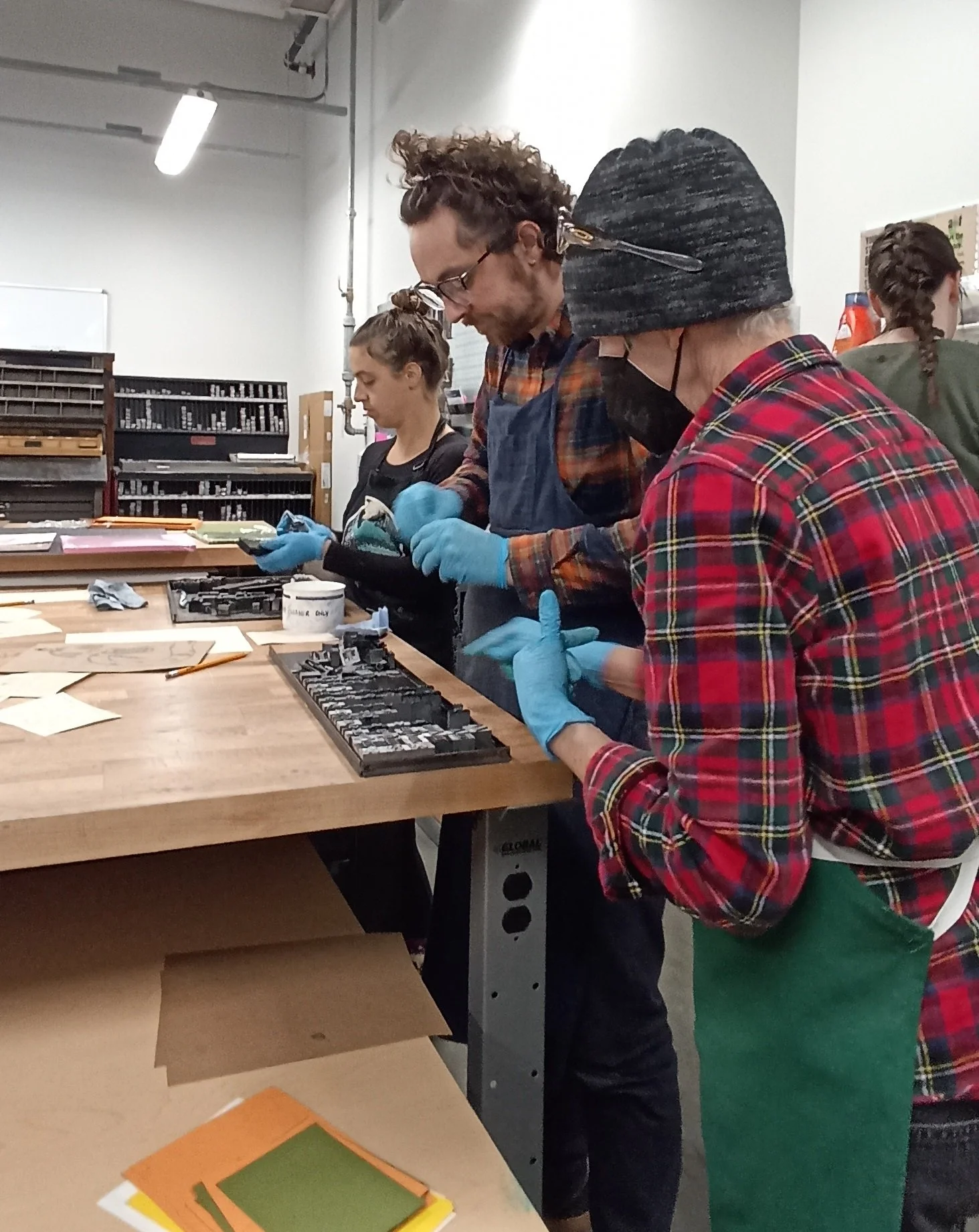Time, Immortality, and the Art of Letterpress Printing
Photo: Shalini Singh
Personal Essay: ‘Is time a love story? Maybe time is letterpress printing. A capsule where every printed letter is a love letter to the future. And it’s a letter that doesn’t end with the ink drying or the writer moving away.’
“I'll write to you. A super-long letter, like in an old-fashioned novel” ― Haruki Murakami, After Dark.
Time is a machine, maybe. Time is a tell-tale. Time is ever encompassing when you do what you love and what you must have loved, but in this lifetime, you have forgotten.
Is time a love story? Maybe time is letterpress printing. A capsule where every printed letter is a love letter to the future. And it’s a letter that doesn’t end with the ink drying or the writer moving away.
Letterpress originated in the 1400s and came much before the industrial revolution. Are they pseudo-machines or artifacts of a time machine? Transporting its occupants in a literary blitz. The ampersands beckoning. Print. Press. Print. Press.
Letterpress printing taught me about my peers and I as no other mortal motor could. In the ‘serious looking’ lab space, we found in ourselves personalities that danced, mused, and amused us all, a transmission of joy at the sight of a long-forgotten instrument.
As my professor, Barbara Haas says:
Students steeped in the literary arts, as opposed to the fine arts, will not typically have had pragmatic experience in studio spaces, where one must manipulate materials and gain control over them—in this case, vintage presses, lead sorts, wood type. They may not have had the experience of waiting their turn before creating the art—in this case, locking down the form on the press bed and then printing a series of copies. Cleaning the equipment afterward might be a novel experience, too.
Printing well on letterpress is an art; as such, it takes years of focused effort to gain proficiency.
When I started my MFA program at Iowa State University, I knew I was choosing a program that was magical in its locality and juxtaposition. Experiences and activities that make a writer are also what breaks the ego, builds character, and question methods. Every day is a new adventure, and also the same old, but never once boring. Boredom can be dangerous in a place like Iowa, and many will confirm but an environment like the one once you enter the Ames campus of ISU is exactly the opposite. There is too much life, too much to do, so much to experience. In our practicum lie hidden gems, like the opportunity to explore the world of letterpress printing.
Photo: Shalini Singh
A question arose in my mind many times: Are letterpress machines? Letterpress originated in the 1400s and came much before the industrial revolution. Are they pseudo-machines or artifacts of a time machine? Transporting its occupants in a literary blitz. The ampersands beckoning. Print. Press. Print. Press.
According to Yellow Pages, Ames, Iowa has at least twenty-five working letterpresses, but I think they are lying. What I know is that a very generous alumnus provided (donated) a whole warehouse of printing and pressing devices, tools, and beautiful motifs to ISU. He made sure that history did not sit defunct in his basement and continued to be made.
I manifested giving to the future then and there. What a text like Letterpress Printing: A Manual for Modern Fine Press Printers by Paul Maravelas could teach in 200 words of theory, we learned much more in 6 hours of instructive embodiment in a welcoming space with the wise and patient Professor Haas. By the end of the travails in the small compact room, the time machine gifted me with more than hundreds of cards and work-in-progress notes that I salvaged quite literally from the waste baskets. Several acquaintances and friends were happy with my salvaging. None could be happier than I was. “Waste to best” and “Rags to riches”, as Professor Haas quipped.
It is not vainly that letterpress printing is also known as relief printing. The collective sighs and ahs in the lab were special, like the joy of children buttoned in a cushy parlour, left with our favourite toys.
Toys were also time machines. And lest we forget time, our child-like selves were warped in an elegy; an epiphany every second of a minute that we were alive in there.
An early form of the printing press was also known as a “screw press,” a fact illuminated by Wenger imprinting ‘Dyke’ cards. My peers found their illuminations, too. Connor’s persona on paper was visible through his vulnerable, heartfelt lines. Seemi wrote one word, ‘Maktoob,’ and our names in Urdu—which was a sight to behold. Claire’s precious words glistened as one of a kind, and Zoe came alive on the smallest of font sizes. Eleanore’s tribute to Taylor was an astral vision, and Evie’s words were hers—and hers alone.
I also churned out many ‘THANK YOU’ cards in fonts, blocks, and paints, that would be parallel to the time when Virginia Woolf was inscribing history on her Hogarth Press in a wormhole of a time. (I am full of gratitude these days, and I have the universe to thank. No number of cards or thank you can subscribe to the intensity in my heart.)
Photo: Shalini Singh
There was a time when, as a child, I would note in my stencil notebook that my future child would be called ‘Anais,’ never knowing there was already an existence so powerful that it had already left an indelible print on the hearts and minds of readers. It was the wonder of letterpress that manually printed Anais Nin’s famous words in her third book Winter of Artifice in 1942: “You live with your hands in acts of physical deftness.”
A time that made me write and learn calligraphy. A time that taught me how to make greeting cards, because we could not afford Archies and Hallmarks. A time that taught the importance of scrapbooking to a teenager who never in her wildest dreams (and there were many!) imagined sitting in the fertile lands of unimaginable vastness, “The Dinkey,” (Proclamation of the history of the city of Ames, by first Mayor Stuart N Smith) and the land of productivity and dreams for thousands of writers since 1853 who have traversed solitude, wonder, and peace to disseminate.
Later we cleaned, scrubbed, sanitized, and in a trance, were one with time. Most of us had stepped into this monastery of inks, letters, and motifs for the very first time, and it had felt like forever. It felt bittersweet to bid our goodbyes to the ‘now drying’ and ‘transitioning’ pieces of artwork. The sweet struggle was a dent in eternity, when we did not mind the sun going down on us all, and welcomed every star in the sky shining on us outside. Our hearts were full, eyes misty with the lead in the air, and only our hands were tired. I felt exhilarated. Nirvana.
Now, I can only hope to return to the lab in the spring. I cannot wait.
What was essential and luxury to my heroes is now a modern-day meditation to me. A deep meditative art with collaborative consonance. A deeply inventive art form, a form of immortality.
***
Shalini Singh’s work has been published or is forthcoming in The Nation, LitGleam, Kitaab, AOTHM, YNTHT, Poetically, Poppy WordPress, The Spectacle, Tofu Ink Press amongst others. She published the prose poetry book Confessions of a Turophile in 2018. She was recently longlisted for 20 Under 30 South Asian Writers for Fiction and nominated for a Pushcart Prize. You can find her on Twitter: @belladonnaoflav and Instagram: @belladonnaoflavender.



